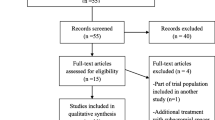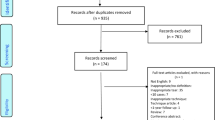Abstract
Purpose
The optimum treatment strategy for the surgical management of partial-thickness rotator cuff tears (PTRCT) is evolving. In this study, two research questions were sought to be answered: “Does the repair technique for PTRCTs involving >50% of the tendon thickness have an effect on structural and functional outcomes of arthroscopic repair?” and “Is there a difference in outcomes of arthroscopically treated articular- and bursal-sided PTRCTs?”.
Methods
A systematic review according to the PRISMA statement was conducted to identify all literature published reporting on outcomes of arthroscopic treatment of PTRCTs classified with the Ellman classification with minimum 2-year follow-up. Prospective randomized trials were eligible for quantitative synthesis. A total of 19 studies, published between 1999 and 2015, met the inclusion criteria of this systematic review. Two studies reporting outcomes of articular-sided PTRCTs with prospective randomized study design were included in quantitative synthesis calculations.
Results
Arthroscopic repair of PTRCTs >50% thickness results in significant pain relief and good to excellent functional outcomes. When in situ repair was compared with repair of the tendon after completion to full-thickness RCT, there were no significant differences in functional or structural outcomes or complication rates. The best treatment method for low-grade PTRCTs remains unclear.
Conclusions
The repair technique (in situ repair versus repair of the tendon after completion to full-thickness RCT) did not significantly affect the outcomes for arthroscopic repair of PTRCTs >50% thickness. The current literature contains evidence for inferior outcomes and higher failure rates after arthroscopic debridement of bursal-sided compared to articular-sided PTRCTs, and some evidence suggests that repair of lower-grade bursal-sided tears may be beneficial over debridement.
Level of evidence
IV.

Similar content being viewed by others
References
Chang KV, Hung CY, Han DS, Chen WS, Wang TG, Chien KL (2015) Early versus delayed passive range of motion exercise for arthroscopic rotator cuff repair: a meta-analysis of randomized controlled trials. Am J Sports Med 43:1265–1273
Chung SW, Kim JY, Yoon JP, Lyu SH, Rhee SM, Oh SB (2015) Arthroscopic repair of partial-thickness and small full-thickness rotator cuff tears. Am J Sports Med 43:588–596
Connor PM, Banks DM, Tyson AB, Coumas JS, D’Alessandro DF (2003) Magnetic resonance imaging of the asymptomatic shoulder of overhead athletes: a 5-year follow-up study. Am J Sports Med 31:724–727
Cordasco FA, Backer M, Craig EV, Klein D, Warren RF (2002) The partial-thickness rotator cuff tear: is acromioplasty without repair sufficient? Am J Sports Med 30:257–260
Curtis AS, Burbank KM, Tierney JJ, Scheller AD, Curran AR (2006) The insertional footprint of the rotator cuff: an anatomic study. Arthroscopy 22:603–609
Deutsch A (2007) Arthroscopic repair of partial-thickness tears of the rotator cuff. J Shoulder Elb Surg 16:193–201
Dugas JR, Campbell DA, Warren RF, Robie BH, Millett PJ (2002) Anatomy and dimensions of rotator cuff insertions. J Shoulder Elb Surg 11:498–503
Duralde XA, McClelland WB Jr (2012) The clinical results of arthroscopic transtendinous repair of grade III partial articular-sided supraspinatus tendon tears. Arthroscopy 28:160–168
Ellman H (1990) Diagnosis and treatment of incomplete rotator cuff tears. Clin Orthop Relat Res 254:64–74
Ellman H, Kay SP (1991) Arthroscopic subacromial decompression for chronic impingement. Two- to five-year results. J Bone Jt Surg Br 73:395–398
Franceschi F, Papalia R, Del Buono A, Vasta S, Costa V, Maffulli N, Denaro V (2013) Articular-sided rotator cuff tears: which is the best repair? a three-year prospective randomized controlled trial. Int Orthop 37:1487–1493
Fukuda H, Hamada K, Nakajima T, Tomonaga A (1994) Pathology and pathogenesis of the intratendinous tearing of the rotator cuff viewed from en bloc histologic sections. Clin Orthop Relat Res 304:60–67
Fukuda H, Hamada K, Nakajima T, Yamada N, Tomonaga A, Goto M (1996) Partial-thickness tears of the rotator cuff. A clinicopathological review based on 66 surgically verified cases. Int Orthop 20:257–265
Harris JD, Quatman CE, Manring MM, Siston RA, Flanigan DC (2014) How to write a systematic review. Am J Sports Med 42:2761–2768
Kamath G, Galatz LM, Keener JD, Teefey S, Middleton W, Yamaguchi K (2009) Tendon integrity and functional outcome after arthroscopic repair of high-grade partial-thickness supraspinatus tears. J Bone Jt Surg Am 91:1055–1062
Kartus J, Kartus C, Rostgård-Christensen L, Sernert N, Read J, Perko M (2006) Long-term clinical and ultrasound evaluation after arthroscopic acromioplasty in patients with partial rotator cuff tears. Arthroscopy 22:44–49
Kim KC, Shin HD, Cha SM, Park JY (2014) Repair integrity and functional outcome after arthroscopic conversion to a full-thickness rotator cuff tear: articular- versus bursal-side partial tears. Am J Sports Med 42:451–456
Koh KH, Shon MS, Lim TK, Yoo JC (2011) Clinical and magnetic resonance imaging results of arthroscopic full-layer repair of bursal-side partial-thickness rotator cuff tears. Am J Sports Med 39:1660–1667
Lo IK, Burkhart SS (2004) Transtendon arthroscopic repair of partial-thickness, articular surface tears of the rotator cuff. Arthroscopy 20:214–220
Lumsdaine W, Smith A, Walker RG, Benz D, Mohammed KD, Stewart F (2015) Morphology of the humeral insertion of the supraspinatus and infraspinatus tendons: application to rotator cuff repair. Clin Anat 28:767–773
Mall NA, Kim HM, Keener JD, Steger-May K, Teefey SA, Middleton WD, Stobbs G, Yamaguchi K (2010) Symptomatic progression of asymptomatic rotator cuff tears: a prospective study of clinical and sonographic variables. J Bone Jt Surg Am 92:2623–2633
Maman E, Harris C, White L, Tomlinson G, Shashank M, Boyton E (2009) Outcome of nonoperative treatment of symptomatic rotator cuff tears monitored by magnetic resonance imaging. J Bone Jt Surg Am 91:1898–1906
Mascarenhas R, Chalmers PN, Sayegh ET, Bhandari M, Verma NN, Cole BJ, Romeo AA (2014) Is double-row rotator cuff repair clinically superior to single-row rotator cuff repair: a systematic review of overlapping meta-analysis. Arthroscopy 30:1156–1165
Matthewson G, Beach CJ, Nelson AA, Woodmass JM, Ono Y, Boorman RS, Lo IK, Thornton GM (2015) Partial thickness rotator cuff tears: current concepts. Adv Orthop 2015:458786
Millett PJ, Warth RJ, Dornan GJ, Lee TJ, Spiegl UJ (2014) Clinical and structural outcomes after arthroscopic single-row versus double-row rotator cuff repair: a systematic review and meta-analysis of level I randomized clinical trials. J Shoulder Elb Surg 23:586–597
Modi CS, Smith CD, Drew SJ (2012) Partial-thickness articular surface rotator cuff tears in patients over the age of 35: etiology and intra-articular associations. Int J Shoulder Surg 6:15–18
Moher D, Liberati A, Tetzlaff J, Altman DG, PRISMA Group (2010) Preferred reporting items for systematic reviews and meta-analyses: the PRISMA statement. Int J Surg 8:336–341
Moor BK, Bouaicha S, Rothenfluh DA, Sukthankar A, Gerber C (2013) Is there an association between the individual anatomy of the scapula and the development of rotator cuff tears or osteoarthritis of the glenohumeral joint? J Bone Jt Surg Br 95-B:935–941
Olsewski JM, Depew AD (1994) Arthroscopic subacromial decompression and rotator cuff debridement for stage II and stage III impingement. Arthroscopy 10:61–68
Park JY, Chung KT, Yoo MJ (2004) A serial comparison of arthroscopic repairs for partial- and full-thickness rotator cuff tears. Arthroscopy 20:705–711
Park JY, Yoo MJ, Kim MH (2003) Comparison of surgical outcome between bursal and articular partial thickness rotator cuff tears. Orthopedics 26:387–390
Park SE, Panchal K, Jeong JJ, Kim YY, Kim JH, Lee JY, Ji JH (2015) Intratendinous rotator cuff tears: prevalence and clinical and radiological outcomes of arthroscopically confirmed intratendinous tears at midterm follow-up. Am J Sports Med 43:415–422
Peters KS, McCallum S, Briggs L, Murrell GA (2012) A comparison of outcomes after arthroscopic repair of partial versus small or medium-sized full-thickness rotator cuff tears. J Bone Jt Surg Am 94:1078–1085
Porat S, Nottage WM, Fouse MN (2008) Repair of partial thickness rotator cuff tears: a retrospective review with minimum two-year follow-up. J Shoulder Elb Surg 17:729–731
R Core Team (2015). R: A language and environment for statistical computing. R Foundation for Statistical Computing, Vienna. http://www.R-project.org/
Ruotolo C, Fow JE, Nottage WM (2004) The supraspinatus footprint: an anatomic study of the supraspinatus insertion. Arthroscopy 20:246–249
Sambandam SN, Khanna V, Gul A, Mounasamy V (2015) Rotator cuff tears: an evidence based approach. World J Orthop 6:902–918
Shin SJ (2012) A comparison of 2 repair techniques for partial-thickness articular-sided rotator cuff tears. Arthroscopy 28:25–33
Shin SJ, Kook SH, Rao N, Seo MJ (2015) Clinical outcomes of modified mason-allen single-row repair for bursal-sided partial-thickness rotator cuff tears: comparison with the double-row suture-bridge technique. Am J Sports Med 43:1976–1982
Wang Y, Lu L, Lu Z, Xiao L, Kang Y, Wang Z (2015) Arthroscopic transtendinous repair of articular-sided pasta (partial articular supraspinatus tendon avulsion) injury. Int J Clin Exp Med 8:101–107
Weber SC (1999) Arthroscopic debridement and acromioplasty versus mini-open repair in the treatment of significant partial-thickness rotator cuff tears. Arthroscopy 15:126–131
Woods TC, Carroll MJ, Nelson AA, More KD, Berdusco R, Sohmer S, Boorman RS, Lo IK (2014) Transtendon rotator-cuff repair of partial-thickness articular surface tears can lead to medial rotator-cuff failure. Open Access J Sports Med 5:151–157
Wright JG, Swiontkowski MF, Heckman JD (2003) Introducing levels of evidence to the journal. J Bone Jt Surg Am 85-A:1–3
Xiao J, Cui GQ (2015) Clinical and magnetic resonance imaging results of arthroscopic repair of intratendinous partial-thickness rotator cuff tears. Chin Med J (Engl) 128:1496–1501
Xiao J, Cui G (2015) Clinical and structural results of arthroscopic repair of bursal-side partial-thickness rotator cuff tears. J Shoulder Elb Surg 24:e41–e46
Yamanaka K, Matsumoto T (1994) The joint side tear of the rotator cuff. A followup study by arthrography. Clin Orthop Relat Res 304:68–73
Acknowledgements
We would like to acknowledge Grant J. Dornan, MSc for his assistance with statistical analysis.
Authors contribution
JCK conceived the study and design, acquired and interpreted data, drafted the manuscript, has given final approval and agrees to be accountable for all aspects of the work. GB conceived the study and design, acquired and interpreted data, helped draft the manuscript, has given final approval and agrees to be accountable for all aspects of the work. GM acquired and interpreted data, helped draft the manuscript, has given final approval and agrees to be accountable for all aspects of the work. DST acquired and interpreted data, helped draft and revise the manuscript, has given final approval and agrees to be accountable for all aspects of the work. PJM conceived the study and design, revised it critically, has given final approval and agrees to be accountable for all aspects of the work.
Author information
Authors and Affiliations
Corresponding author
Ethics declarations
Conflict of interest
Other than GM and PJM none of the other authors declare they have no conflict of interest.
Funding
This research study was not funded directly by any organization but was supported by Steadman Philippon Research Institute and their corporate sponsors.
Ethical approval
This was a systematic review of published literature, and and IRB approval was not required.
Informed consent
Informed consent was not applicable to this study.
Rights and permissions
About this article
Cite this article
Katthagen, J.C., Bucci, G., Moatshe, G. et al. Improved outcomes with arthroscopic repair of partial-thickness rotator cuff tears: a systematic review. Knee Surg Sports Traumatol Arthrosc 26, 113–124 (2018). https://doi.org/10.1007/s00167-017-4564-0
Received:
Accepted:
Published:
Issue Date:
DOI: https://doi.org/10.1007/s00167-017-4564-0




